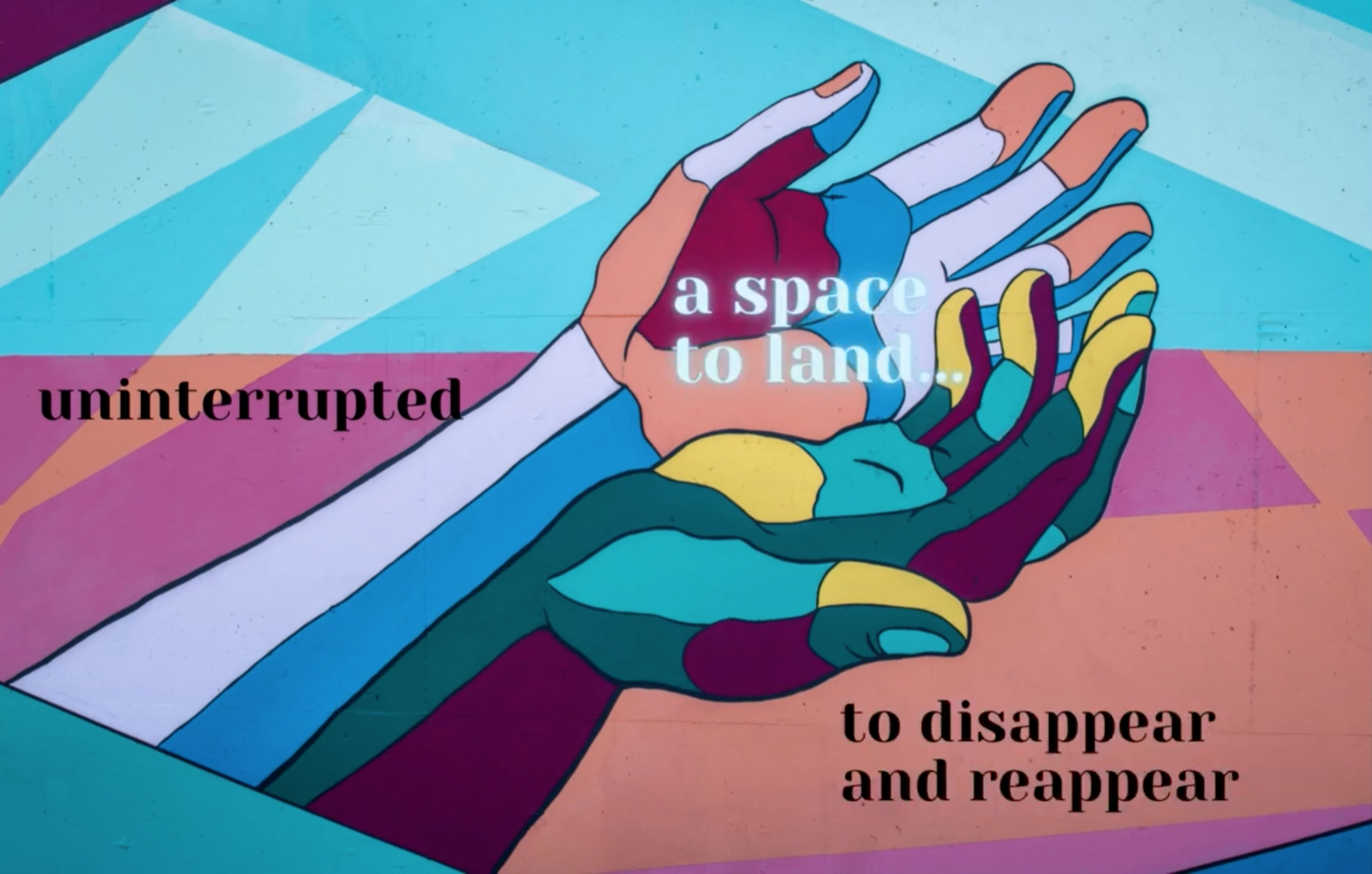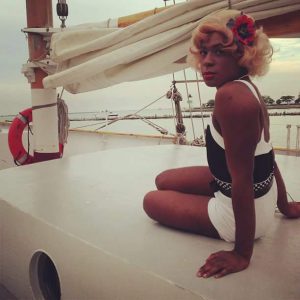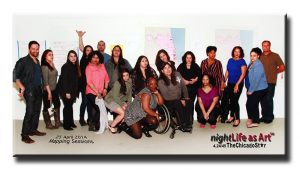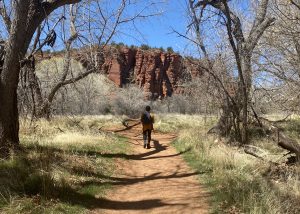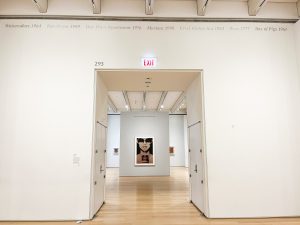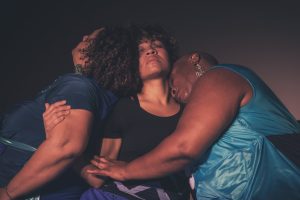Featured image: A video still frame shows a drawing of outstretched hands, rendered in a mixed palette of cool and warm colors. Within the frame are also lines of text which say “a space to land…”, “uninterrupted”, and “to disappear and reappear.” The full video is a creative response to the question “How does it feel and what comprises a sustainable, supportive, care-filled healthy arts ecosystem?” Still frame from a video by Jamila Kinney.
This is the second in a series of articles made in collaboration with the Chicago Arts Census to explore the living, labor, and material realities of art workers in the city of Chicago. Please visit the Chicago Arts Census website to learn more about the Census, how to get involved, and to take the survey.
Click here to read the first article in this series.
As a lifelong Chicagoan and “mid-career” interdisciplinary Black woman artist whose creative praxis centers a marginalized/working-class worldview, I’m a passionate advocate of the Chicago Arts Census (“the Census”). The data collection and mapping tool is yet another example of the vital “for artists, by artists” ethos guiding much of Chicago’s current independent mutual aid-sustained arts ecosystem (do your Googles).
I was raised in the South Shore neighborhood, in the wake of the “white flight” era—South Shore and Gen X, stand up! Not only did my intellectual-yet-working-class parents keep our home filled with books/magazines/music/tv/film about everything (including art & culture), but between the ages of 9-13, I was homeschooled due to my parents’ disillusionment with the various institutionalized education environments I’d been enrolled in—from private, to public, to parochial. Essentially, my exposure to Black creativity/consciousness and community has been lifelong. During Reaganomics, I grew up with living/breathing examples of “it takes a village” and “making a way outta no way”.
So when I was invited to author this piece, I enthusiastically accepted. Not only did this assignment provide me the opportunity to work with people and platforms whose work I highly respect, it provided me another opportunity to archive a nuanced piece of the continued COVID-19 era, and the ways which we’re creatively and nimbly enduring—as producers/practitioners/people/etc… #neverforget.
For those who have yet to complete the Census, let me share a bit of my experience with you. What I found particularly remarkable about the anonymous survey was the level of nuance and clarity in the questions. Real Talk: Most of the questions required a period of remembrance/reflection and introspection in order to provide the most honest/accurate response possible. Having to reflect and answer these ‘Pre-pandemic v. Post-vaccine’ comparative questions simultaneously produced valuable Quality-of-Life data for both the Census (aggregate; macro) and for my personal data archive (individual; micro). For instance, in the section about salary history, there are questions that ask you to recall not only your salary ranges, but instances when you were either “Paid, Unpaid or Underpaid”… THAT is the kinda real talk I’m talking about; that which is usually discussed in hushed tones, not in mixed company. Personally, taking the Census deftly affirmed the axiom that self care and community care are inextricably linked and directly impact each other.
The total estimated completion time is about an hour and a half (there are several short essay questions), and you can save and return to the Census until completed. Each of the six question categories are contextualized within a 2019 through 2021 timeframe. While the work of the Census aims to create advocacy tools and facilitate coalition-building, the artist-run/community-centered/data-based project is also firmly rooted in hope.
Part of that hope mandates envisioning what a care-filled, sustainable arts ecosystem looks and feels like. For this article, we asked a cross-section of Chicago-based arts workers to share their experiences within, and visions of, our city’s artistic community, to envision a sustainable, supportive, care-filled, and healthy arts ecosystem. We asked such questions as “How does it feel?”, “What comprises it?”, “As an arts worker—What has helped you to thrive?”, “Who has helped you feel seen and cared for?”, and “What is not currently supporting you in the arts ecosystem?”.
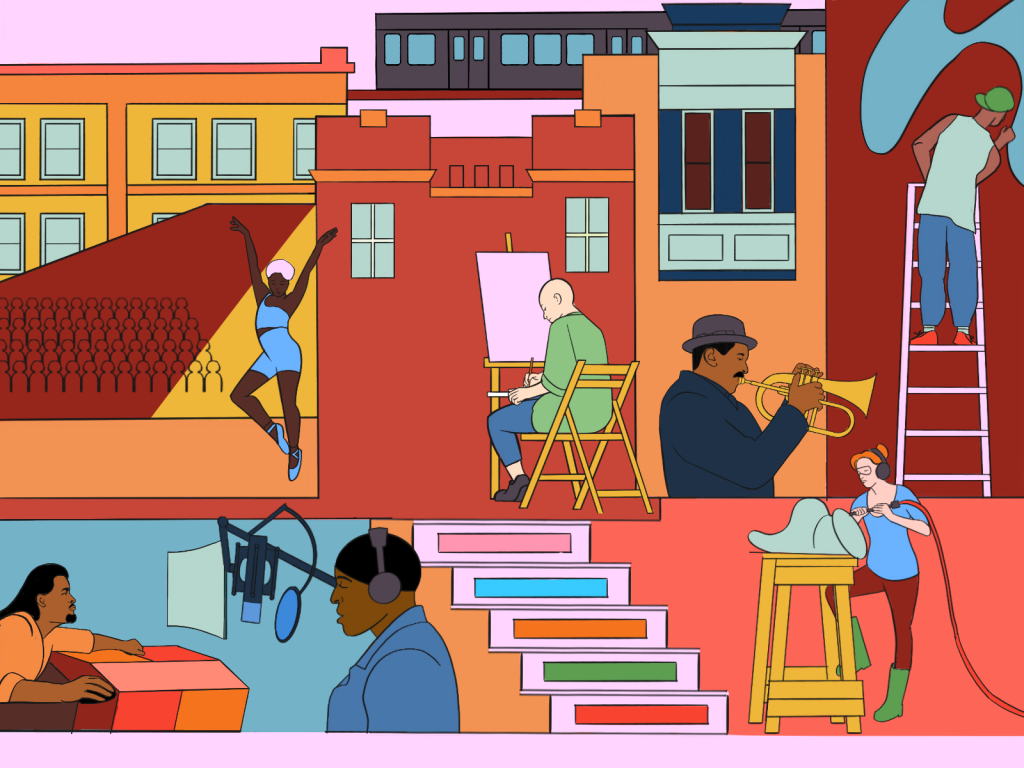
Those questions are so resonant for me because they so accurately reflect questions I’ve been consciously asking myself since at least 2013, the year I added a non-profit performing arts admin position to my multi-hyphenate resume. Crafted to serve as both an exposition and call-to-action, here now is an edited compilation of responses submitted by an interdisciplinary spectrum of queer/femme BIPOC Chicago arts workers:
WILD YAMS Black Mothers Artist Residency founder Wisdom Baty offers her viscerally poetic vision towards a healthy Chicago arts ecosystem, particularly for artists of the African diaspora:
“I vision towards a healthy arts ecosystem
Look Inward
Rejuvenate joyfulness in families + communities
Centers repair + love + jubilee for ancestral stains
Salve on the heart + minds of African/Black/ Diasporic Bodies
An arts ecosystem of warmth, and soul, and laughter, and glow
An arts ecosystem with tables to feast of fruit with seeds
no crumbs. The Full Course Meal. Whole Table. All The Seat
Current parasitic arts ecosystems are dying, crumbling, rightly so. Greedy exploitation is not sustainable. Reparations {B} a guide, a light. Headphones to block the naysayers. WE Said what I said and WE not Saying the same damn things NO Mo’.”
– Wisdom Baty
The following anonymous submission highlights the pervasive harm enacted against artists within the City’s institutional art world, as well as the continued local artist resistance, collaborative DIY space making/community building in order to de-center and divest from the city’s calcified systems of cultural and economic domination:
“When I envision a sustainable, supportive, healthy art ecosystem in Chicago, I imagine de-centering downtown as the mecca to experience art. There’s a plethora of art spaces that cater to all forms of expression—not just 2-D work that’s installed on white walls to be sold. These art spaces intentionally welcome, survey and employ community members so that the art spaces positively function *within* the community and reflect the value system of the community where these art spaces occupy space. In this same ecosystem, art admins do more thorough work to uplift young artists, artists with unconventional practices and artists with smaller followings. Art institutions, nonprofits and organizations are less vague about their infrastructural practices as a whole and more Chicago natives are in essential administrative positions so that authentic, nuanced Chicago art can thrive and be celebrated. More gallerists and curators would incorporate astrology into their programming, e.g not programming major electronic/tech events during periods of time when Mercury is retrograde. There would also be an abundance of free resources for artists to build their professional practice, e.g how to write contracts, file taxes, write grants etc.
The biggest factor that’s helped me thrive is my community of artists, musicians and programmers. Community members have paid me consistently, and oftentimes the most for my work. The way many art institutions function in Chicago makes it hard for me to feel empowered, supported and paid fairly. Many art institutions don’t have one or a combination of resources, imagination, *professional* art administrators/programmers. This makes it difficult and sometimes impossible to produce work and achieve results that everyone involved can be proud of. And the most coveted residencies in Chicago keep giving opportunities to the same group of artists, making the same work about the same digestible, uninspired topics. It’s as if these spaces don’t want any challenging work. There’s barely any local or national press coverage on art that’s occurring in Chicago. I believe this is what reinforces the pipeline to coastal cities. There’s so many brilliant artists in Chicago that are often overlooked by bigger, more notable art spaces because they don’t have friends in administrative positions or don’t have a huge social media following. I’m also particularly exhausted by the optics of inclusivity from larger art spaces in Chicago. I think it’s a great step forward to diversify who gets esteemed opportunities but what does it mean if critical conversations aren’t being had because of *who* is accepted? It’s as if these institutions see inclusivity as some sort of quota they’d rather not rupture by practicing quality control, e.g. a notable art institution flying an artist with a marginalized identity into Chicago to showcase a violent, triggering performance that left many audience members feeling abused and unsafe.”
– Anonymous
Writer/researcher and recent transplant Victoria-Paige Sockwell shares pragmatic testimony how her experience in Chicago’s art world has helped her build grit and community:
“When I envision myself as an artist in a sustainable and healthy art ecosystem, I see myself working and creating art while also paying my bills. I wonder what it would look like to be able to leave my debit card unlocked with no worries of what might come out when I’m resting. I rest with ease and no nightmares of the bills that have yet to be seen. I think about how freeing it would be to not have financial insecurities—to be able to have it all. When my friends invite me out to dinner, I don’t have to choose between going out now and not eating later. I can have my cake and eat it right now while the frosting is still frozen. I am not asking to be a millionaire; I am just asking not to have to choose between living and surviving.
Despite all the challenges, I wouldn’t be this strong if it wasn’t for the love I received and for the mistakes I have made. I am thankful for supportive friends and family members. I am grateful for a supportive partner and friend who is also an artist. I am grateful to have friends and mentors who work in the arts. I’ve always been the youngest in my friend groups and that has allowed me to learn from their wisdom. I’m grateful for friends who make you name yourself (I am a writer, I am an artist) and speak positive affirmations into my life. The people in my life who have made the biggest impact have no idea the hold they had on me when I first started and how I carry their energy with me today as I curate, write, research, and move.”
– Victoria-Paige Sockwell
Somatic movement practitioner Jamila Kinney’s video submission reflects on the question, “How does it feel and what comprises a sustainable, supportive, care-filled healthy arts ecosystem?”:
“Thank you for the space to reflect and create.”
– Jamila Kinney
Teaching artist and MAAE candidate Sarita Garcia shares her field notes and assessments on accessibility to arts education and public programming in Chicago:
“If I were to summarize what a sustainable and healthy arts ecosystem feels and comprises, it would be: Livable wages, health care, affordable housing, access to resources, job opportunities, artists unions, surplus of grants for artists, free artist tax classes, free education to further a practice, affordable studio spaces and lawyers dedicated to aid artists. I would also imagine it activating public spaces like, art centered events, dedicated spaces for communal healing and care through modes of art. This means more community access to the arts and programming. I also would hope this arts ecosystem reaches to the youth and educators, like funding for young artists, funding for CPS art teachers and funding for contract teaching artists. Within this imaginative arts ecosystem rooted in hope, I would feel safe to be a creative and cultural worker in the field. I would feel like I have agency to create programming that is centered around public art making with community members that is hyper-local and practiced through small movements and trust. I would feel supported by my city in seeing the importance of arts integration within all modes of work and celebration.
I moved to Chicago in 2014 and have been working as a Teaching Artist, Cultural Worker and Artist in the South and West Sides. Currently, I am attending the School of the Art Institute of Chicago for my Masters of Arts in Arts Education (MAAE). My deeply loved arts community has helped me thrive since moving here. I am extremely grateful for the care they have given me in allowing me to create public programming, teach young artists, exhibit in their spaces, create murals, host workshops, teach classes, and feel supported and cared for. I particularly want to shout out Vanesssa Sanchez, the Director of Education at the National Museum of Mexican Art, whose practice I want to emulate in everything I do, has supported me in many ways through my art career and most importantly my teaching practice. Getting the chance to meet her and work alongside her has been a springboard for learning and growth. And also the whole Yollocalli crew that works as a team. They rock!!
What is not supporting me in the arts ecosystem is job security and pay. I am an Arts Educator working as a Contract Teaching Artist in many institutions, nonprofits and small organizations. There are so many perks to being a Contract Teaching Artist, but working these small gigs has plenty of slippery slopes we fall into. Contracts are constantly shifting, pays are consistently being cut, hours are being shortened, some workplaces don’t provide prep needed to teach a classroom, we are given so many students per instructor, small budgets for materials, no work benefits, no health care, no job security, we are often seen as disposable and easily replaceable. Our work is done through the passion for teaching and working with youth and community. A lot of the work that is done by arts educators is integral to the pillars of many nonprofit organizations, especially when they are writing their grants. Why are we not treated like vital key members of their workplaces? We are the cultural workers creating community and retention in these programs. We need to be treated like we are important because we are.”
– Sarita Garcia
Opera performer, arts administrator and curator Courtney Cintron recounts how her experiences in collaboration as a performing artist continues to impact and inspire her varied work within and commitment to Chicago’s artist-driven ecosystem:
“Arts communities in Chicago are fierce. I’ve worked and dedicated most of my life to arts, artistry, and artists in Chicago; working in varying capacities from opera performer to administrator to exhibitions and program curator, and I have never stopped being inspired and motivated by my fellow arts workers. Although there is no doubt a lot of work to do; it continues to be a space that is constantly questioning, relentlessly evolving, and boldly holding both itself and institutions accountable to addressing disparities in leadership, funding, representation, and access across racial, ethnic, gender, sex, and class lines.
Starting my career off as an opera performer, I was trained to work collaboratively, listen intently, and respond authentically in support of my fellow singers and the greater performance. These ideals were also reciprocated, and I often felt my most seen and cared for in the context of these unique exchanges and dynamic productions. I have carried many of these values forth in my roles as arts administrator and curator, employing my background in music to consider the rhythm, harmony, and flow of all of my endeavors, projects, and human connections.These formative experiences, relationships, and lessons learned have been vital sources of inspiration; making it possible for me to thrive in all my many arts transmigrations.”
– Courtney Cintron
Artist and arts programmer Tamara Becerra Valdez provides glimpses into her somatic visions and signs of healthy vs. unhealthy arts ecosystems:
“A healthy arts ecosystem needs co-liberation at the forefront. I like to imagine the rebuilding process as a collective one. Who will light the fire? Who will build the roof? Who will tend to the garden? Who will orchestrate the songs? Who will lead in dance? Envisioning a ‘sustainable and supportive, care-filled, healthy arts ecosystem’ requires a considerable rebuild, from the ground up. A healthy ecosystem searches for balance, forms new pathways and networks, and recognizes its kin. On a global level, crisis has become so overwhelming that we have no choice but to use our creative imagination to rebuild and heal.
An unhealthy arts ecosystem feels like a symptom of the disorienting and troubled times we are living in. What have we inherited? How do we let go of what we thought we wanted for ourselves and our future? A lot of us are grappling with those changes and shifts. It’s an existentially stressful time to be alive in this world. The societal constructs we have leaned on and believed in are now bent and cracked. It’s precarious.
We are experiencing a major growing pain and few of us have had the opportunity to find rituals for preservation and tending to our grief. Decolonization is a death ritual. I see a decomposition—a raw breakdown of ourselves and our planet in order to regenerate and transform.
We have a world to remake.
Loosen the grip.
Learn to time travel.
Move more fluidly.
This shift is a somatic experience.
When it comes to being an artist in this extraordinary time, where can our creative imagination take us? What is in our toolbox for rebuilding?
We need an arts ecosystem that is leveled, intersectional, and regenerative.”
– Tamara Becerra Valdez
These testimonies are just a snapshot of how much QTBIPOC arts workers in this city have and continue to contribute to Chicago’s renown as an incubator of collectivity/collaboration/community. The ties that bind the visions and testimonies presented here are that they each represent how agency/autonomy and mobility are core ‘Quality of Life’ markers that everyone deserves, including arts workers. Pondering my own answers to the previous prompts, I am fortified in my continued overall vision and hope for a healthy and sustainable arts ecosystem: Creatives’ progressive divestment from performative/exploitative/extractive/colonized systems and institutions! Mutual aid is how many of us QTBIPOC arts & culture workers were “making it work”, pre-pandemic. Now in 2022, as America’s asinine COVID-19 response continues with no end in sight (after two agonizing years, already), out-of-control inflation drives up the cost of everything while wages still largely remain stagnant and a third world war looms large in Europe, the AAVE adage “we all we got” now rings truer than I ever could’ve imagined in 2019. The time is ripe to seize not just the day, but to leverage our power—to rest (s/o The Nap Ministry), to dream, to manifest for/by and with our communities.
As I observe the throes of late-stage capitalism and the Great Resignation continue across industries, I’m reminded of a passage from Assata Shakur’s autobiography:
“It is our duty to fight for our freedom.
It is our duty to win.
We must love each other and support each other.
We have nothing to lose but our chains.”
With a groundbreaking arts worker-run advocacy tool like the Census now available, the paradigm pendulum seems to be shifting in very strategic ways ever closer towards the creative community’s autonomy and leverage. TAKE THE CENSUS!
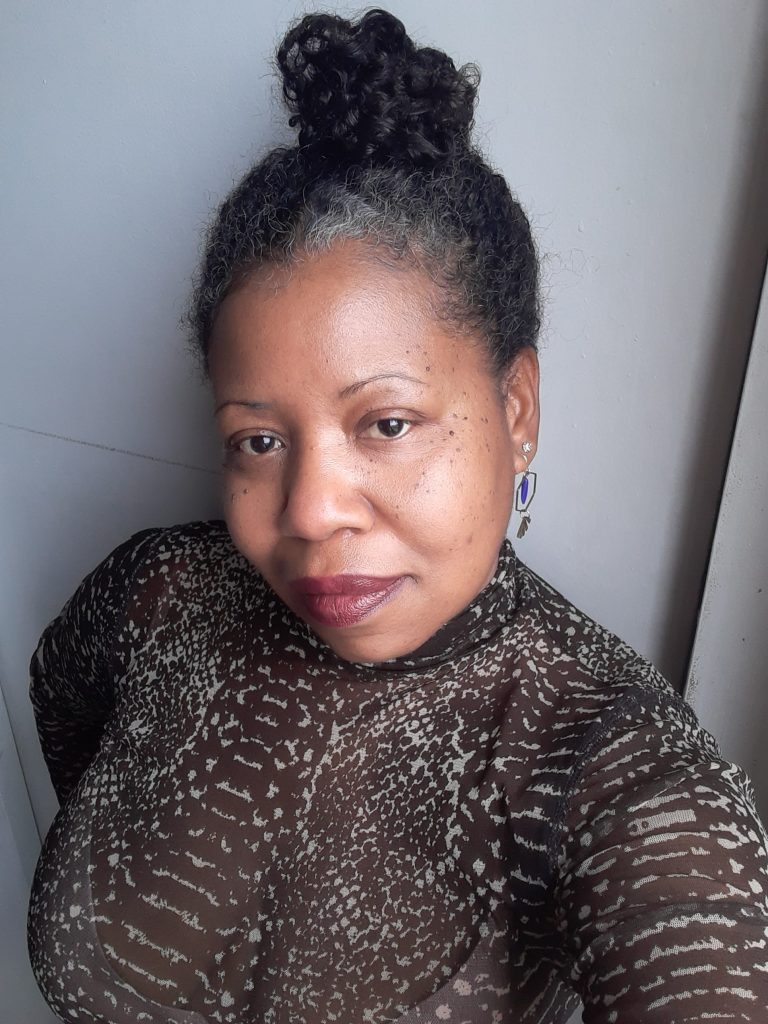
2020-2022 Threewalls RaDLOW fellow Felicia Holman is a native Chicagoan, independent cultural producer/facilitator, and a co-founder of Afrodiasporic feminist creative collective Honey Pot Performance. She is also a co-organizer of the re-launched Performance Response Journal platform. Felicia’s creative/professional and social practices are firmly grounded in critical thought, intersectionality, community building and embodied storytelling. Recent projects include her completed virtual “Welcome to Bucktown” public conversation series and corresponding creative video documentation, as well as commissioned performances for Gallery 400, Illinois Humanities and the 5th annual Instigation Festival. In addition to her work with Sixty Inches From Center, Felicia has published contributions at See Chicago Dance, 6018North, and The Quarantine Times (published by Public Media Institute). Currently, Felicia’s work includes co-facilitating a biweekly virtual affinity group for emerging BIPOC arts residency leaders. Felicia relishes her artrepreneurial life and sums it up in 3 words—”Creator, Connector, Conduit”.
